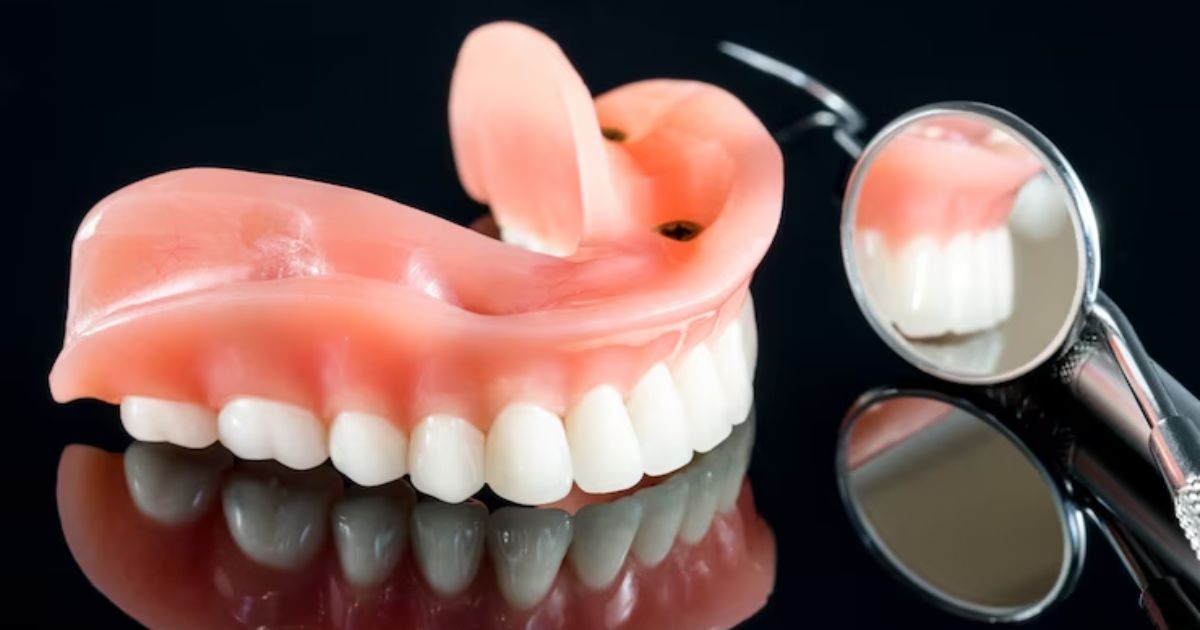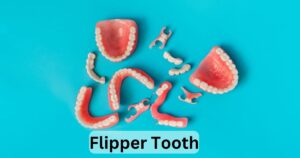Immediate dentures are prosthetic appliances designed to replace missing teeth immediately after tooth extraction. Unlike traditional dentures that are fitted after the gums have healed post-extraction, immediate dentures are prepared in advance and placed in the mouth right after the removal of natural teeth.
This approach ensures that the patient doesn’t have to go without teeth during the healing period. Immediate dentures not only serve cosmetic purposes by maintaining the appearance of the smile but also aid in functions like speech and eating during the initial healing phase.
The process involves taking measurements and impressions of the patient’s mouth before the extraction, allowing for the creation of dentures that can be inserted immediately after tooth removal. While they offer immediate restoration, adjustments and realignments may be necessary as the gums heal and change shape.
Although convenient, immediate dentures require diligent care and frequent follow-up visits to ensure proper fit and functionality as the mouth heals and settles.
Benefits of Immediate Dentures
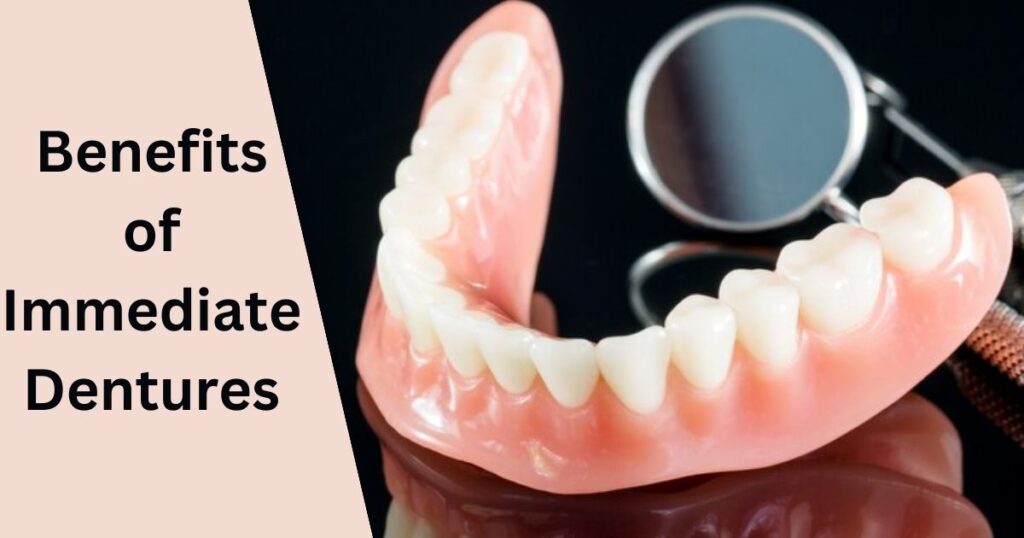
Immediate dentures offer several benefits for individuals undergoing tooth extraction:
Immediate Restoration
Immediate restoration refers to the prompt replacement of missing teeth or dental structures immediately after their removal. This approach ensures continuity in appearance and function without a gap in the smile. Immediate restoration techniques.
It includes immediate dentures or implants, aim to restore aesthetics and functionality promptly. By providing instant replacements, they help patients avoid the discomfort and inconvenience of living without teeth while supporting essential functions like speaking and chewing during the healing process.
Preserve Facial Structure
Preserving facial structure is crucial after tooth loss. Immediate dentures play a pivotal role by filling the gaps left by extracted teeth, preventing the collapse of facial contours. By supporting the lips and cheeks, they maintain natural facial dimensions, averting the sunken appearance that often accompanies missing teeth.
This preservation not only contributes to a more youthful look but also helps maintain overall oral function, ensuring a more confident and comfortable experience for individuals adapting to dentures.
Functional Support
Functional support refers to the assistance provided by dental prosthetics like immediate dentures in facilitating essential oral functions. These prosthetics aid in activities like speaking and chewing, which can be challenging after tooth extraction.
Immediate dentures ensure that individuals can maintain a more normal lifestyle during the initial healing phase by enabling proper speech articulation and adequate chewing function. This support enhances comfort and confidence, allowing individuals to continue their daily activities with minimal disruption despite the absence of natural teeth.
Psychological Comfort
Psychological comfort refers to the emotional and mental ease that individuals experience in various situations. In the context of immediate dentures, it encompasses the sense of confidence, self-assurance, and well-being that arises from having a complete smile.
Having immediate dentures can alleviate anxiety and embarrassment associated with missing teeth, fostering a positive self-image. This comfort extends beyond aesthetics, influencing social interactions and self-perception, ultimately contributing to improved mental health and a more positive outlook on daily life.
Healing Support
Healing support in immediate dentures involves their role as protective covers over extraction sites, aiding in quicker recovery. By shielding the gums and underlying tissues, these dentures minimize bleeding and potential irritation.
This protective layer contributes to a more comfortable healing process. It allows the gums to gradually adjust and minimizes the risk of complications. This support accelerates the initial phases of recovery, promoting better oral health and faster adaptation to the denture.
Transition Aid
Transition aids, like immediate dentures, play a pivotal role in easing the adjustment period for individuals adapting to significant dental changes. By providing immediate replacement for extracted teeth, these aids bridge the gap between tooth loss and denture wear.
They offer a smoother transition, helping patients gradually acclimate to wearing dentures and alleviating concerns about appearance and function. This supportive step minimizes the impact of the change, facilitating a more comfortable and confident adjustment to a new dental routine.
While these benefits are significant, proper care, adjustments, and follow-up visits are crucial to ensure optimal fit and comfort as the gums heal and change shape.
Procedure for Getting Immediate Dentures
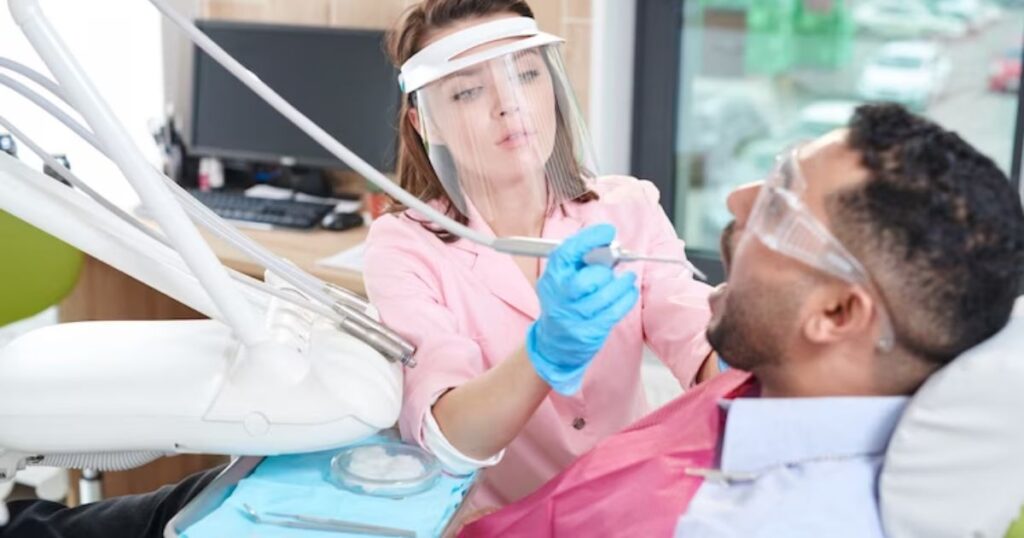
The procedure for obtaining immediate dentures typically begins with a comprehensive dental examination. After determining the suitability for dentures, impressions and measurements of your mouth are taken. These measurements serve as a blueprint for crafting the immediate dentures.
Prior to the extraction of any remaining teeth, the dentures are fabricated. On the day of the extractions, the immediate dentures are inserted immediately after the removal of the teeth. This allows for a seamless transition and ensures that you won’t be without teeth during the healing period. There may be adjustments needed as the gums heal and change shape, requiring follow-up visits to the dentist to ensure a proper fit for optimal comfort and function.
Adjusting to Immediate Dentures
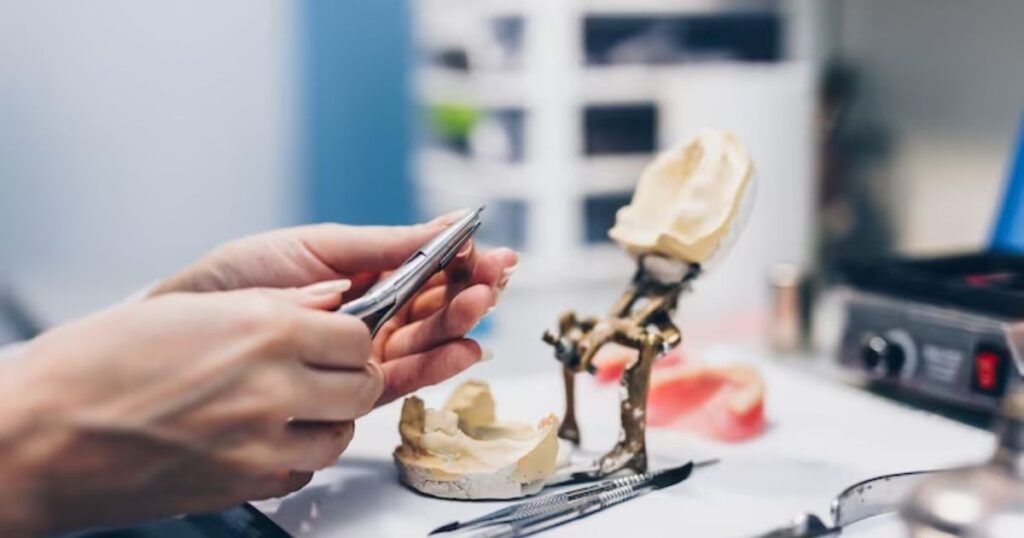
Adjusting to immediate dentures can be a unique experience for individuals. Initially, there might be some discomfort or difficulty speaking and eating as the mouth adjusts to the new prosthesis. It’s common to feel a sense of fullness or pressure due to swelling or changes in the oral tissues.
As the mouth gets accustomed to the dentures, these sensations usually diminish. Patience is key during this phase, and following the dentist’s instructions for wearing the dentures and practicing good oral hygiene can significantly aid in the adjustment process.
Gradually, speaking and eating become more natural, and as the mouth settles, adjustments might be necessary to ensure a comfortable fit for optimal functionality and comfort. Regular follow-up appointments with the dentist facilitate this adjustment period, ensuring any issues are addressed promptly.
Care and Maintenance of Immediate Dentures

Certainly! Here’s a simple chart outlining the care and maintenance of immediate dentures:
| Care and Maintenance Steps | Description |
| Cleaning | Brush dentures daily using a soft-bristled brush and mild denture cleaner. Rinse thoroughly after. |
| Soaking | Soak dentures in water or a denture-soaking solution overnight to keep them moist. |
| Handling | Handle dentures carefully to avoid damage. Use a towel or basin of water when cleaning or handling. |
| Oral Hygiene | Brush gums, tongue, and palate gently with a soft toothbrush to maintain oral health. |
| Avoiding Damage | Avoid using hot water, abrasive cleaners, or harsh chemicals as they can damage dentures. |
| Regular Check-ups | Visit the dentist for adjustments, evaluations, and to address any issues with the dentures. |
This chart serves as a quick reference for the key steps involved in caring for immediate dentures to ensure longevity, cleanliness, and oral health.
Potential Challenges with Immediate Dentures
Several challenges might arise with immediate dentures:
Adjustment Period
The adjustment period for new dentures can be both physically and emotionally taxing. Initially, discomfort, speech impediments, and difficulty eating are common as the mouth acclimates to the prosthesis. This phase demands patience and perseverance as the oral tissues adapt to the dentures.
Sore spots or irritation may arise, necessitating adjustments for a better fit. Speech clarity and eating habits gradually improve with practice and time. Regular follow-ups with the dentist are vital during this phase to address any concerns and ensure the dentures fit well. Ultimately, perseverance through the adjustment period leads to increased comfort and functionality with the dentures.
Gum and Tissue Changes
Gum and tissue changes refer to the alterations in the oral cavity following tooth extraction or changes in dental structures. After tooth removal, gums undergo healing, leading to shifts in size, shape, and density. This natural healing process impacts the fit of dentures, requiring adjustments or relining to maintain a proper and comfortable fit.
Moreover, bone resorption, a gradual loss of bone volume, occurs over time, affecting the jaw’s structure. These changes can compromise the stability and fit of dentures, necessitating regular dental assessments and potential modifications to ensure optimal functionality and comfort of the prosthetic device.
Sore Spots
Sore spots in dentures often result from friction or pressure against sensitive areas in the mouth. These spots, marked by redness or tenderness, typically occur during the initial wear or when dentures need adjustment due to changes in oral tissues. They can cause discomfort, making it essential to seek prompt dental care.
Dentists use various techniques to alleviate sore spots, such as adjusting the denture’s fit or employing soft relines to cushion sensitive areas. Regular follow-ups ensure these issues are addressed promptly, enhancing comfort and allowing for a smoother transition to wearing dentures while minimizing discomfort and irritation.
Speech and Eating Challenges
Adapting to immediate dentures often involves temporary speech and eating challenges. Initially, speech might sound altered or unclear due to the presence of the new dental prosthesis. Pronunciation adjustments and consistent practice aid in overcoming these hurdles. Likewise, eating can pose difficulties as the mouth adjusts to the dentures.
Chewing may feel different, and certain foods might be harder to manage initially. Gradually, as the mouth becomes accustomed to the dentures, speech clarity improves, and eating becomes more natural. Patience, practice, and following the dentist’s guidance play pivotal roles in overcoming these temporary challenges for a smoother transition.
Bone Resorption
Bone resorption refers to the natural process where bone tissue breaks down and diminishes over time. In the context of dentistry, it often occurs following tooth loss or extraction. When a tooth is removed, the surrounding bone no longer serves its original purpose, leading to gradual reduction or resorption.
This phenomenon can result in changes to the jaw’s shape and structure, affecting the fit of dentures or other dental prosthetics. Bone resorption highlights the importance of timely interventions such as implants or regular adjustments to dentures to maintain proper oral function and preserve the jawbone’s integrity for improved dental health and comfort.
Addressing these challenges involves regular dental visits, proper care, and patience during the adaptation phase to ensure the best fit, function, and comfort with immediate dentures.
Potential Challenges with Immediate Dentures
Certainly! Here are some potential challenges associated with immediate dentures:
Initial Discomfort: Adjustment to immediate dentures can cause discomfort initially, including soreness, irritation, or difficulty speaking and eating. Patience and gradual adaptation are essential during this phase.
Gum and Tissue Changes: After tooth extraction, gums and oral tissues undergo healing and reshaping, affecting the denture fit. Regular adjustments or relining might be necessary to ensure a proper and comfortable fit.
Sensitivity and Sore Spots: New dentures can cause sore spots or sensitivity due to pressure points. Denture adjustments and periodic evaluations are crucial to alleviate discomfort.
Speech and Eating Challenges: Speaking clearly and eating comfortably may be temporarily affected. Practice and adjustments aid in overcoming these initial challenges.
Bone Resorption: Following tooth extraction, the jawbone may gradually shrink or change shape. This natural process, known as bone resorption, can impact denture fit over time, necessitating adjustments or modifications.
Addressing these challenges involves close collaboration with a dentist, adhering to proper care routines, and understanding that some discomfort or adjustments may be part of the adaptation process to ensure optimal fit and function of immediate dentures.
Follow-up Visits and Aftercare
After receiving immediate dentures, follow-up visits and aftercare play crucial roles in ensuring their effectiveness and longevity. Regular appointments with the dentist are essential to monitor the dentures’ fit, make necessary adjustments, and address any discomfort or issues experienced by the wearer.
These visits also offer an opportunity to assess oral health and provide guidance on proper denture care. Additionally, maintaining good oral hygiene through daily cleaning of the dentures and the oral cavity is vital. Following dentist-recommended cleaning routines and adhering to aftercare instructions significantly contribute to the comfort, functionality, and durability of immediate dentures.
Comparing Immediate Dentures to Traditional Dentures
Certainly! Here’s a comparison chart outlining the differences between immediate dentures and traditional dentures:
| Aspect | Immediate Dentures | Traditional Dentures |
| Placement Time | Placed immediately after tooth extraction. | Fitted after the gums have healed post-tooth extraction (several weeks to months). |
| Healing Process | Accommodates healing gums and tissues, may need adjustments. | Placed on fully healed gums, fewer adjustments post-fitting. |
| Convenience | Immediate replacement of missing teeth, no extended waiting period. | Requires a waiting period without teeth before placement. |
| Adaptation Period | Requires adjustment to fit changes in healing gums, may cause discomfort initially. | Less adaptation needed as placed on healed gums, minimal discomfort. |
| Follow-up Visits | More frequent follow-up appointments for adjustments and evaluations. | Fewer follow-ups needed after the initial fitting. |
| Cost | Potentially higher cost due to more adjustments and immediate placement. | Generally lower cost due to fewer adjustments post-placement. |
This chart provides an overview of the key differences between immediate dentures and traditional dentures, highlighting aspects such as placement time, adaptation period, follow-up visits, and cost, aiding in understanding their variances and considerations for choosing between the two options.
FAQ’s
How long can you wear immediate dentures?
Immediate dentures are designed to be temporary, only worn for about 6 to 8 months until the arrival of a permanent denture.
What is the protocol for immediate dentures?
Do not chew with the denture, as this can create a pumping action that can increase bleeding. Avoiding rinsing, spitting, smoking, or the use of a straw for the first 24 hours. If heavy bleeding continues, remove the denture and bite on folded gauze pads firmly for 1–2 hours.
What are the options for immediate dentures?
Immediate dentures are complete dentures or partial dentures inserted on the same day, immediately following the removal of natural teeth. You shouldn’t have to wait several weeks for your mouth to heal after your tooth extractions – or feel self-conscious for an additional month while your dentures are being made.
Can I eat with immediate dentures?
During the first 24-36 hours you need to eat food that does not require chewing.
Can you kiss with immediate dentures?
If you have implant dentures, you can kiss without taking any special precautions. However, if you have a traditional prosthetic, there are a few things you should keep in mind: Keep your lips soft, and don’t apply too much pressure or suction on your dentures.
Conclusion
Immediate dentures offer a swift solution for those needing immediate tooth replacement, providing functionality and aesthetics right after tooth extraction. Despite the initial adjustment phase and the need for more frequent adjustments due to healing gums, they offer convenience by eliminating the waiting period without teeth.
However, their fit may change as the gums heal, requiring periodic adjustments. Using specialized denture toothpaste helps maintain their stability. While they might entail higher initial costs and more follow-up visits, immediate dentures ensure continuity in appearance and oral function during the critical healing phase.
Their advantages in prompt restoration underscore their significance as a transitional measure before more permanent dental solutions.
